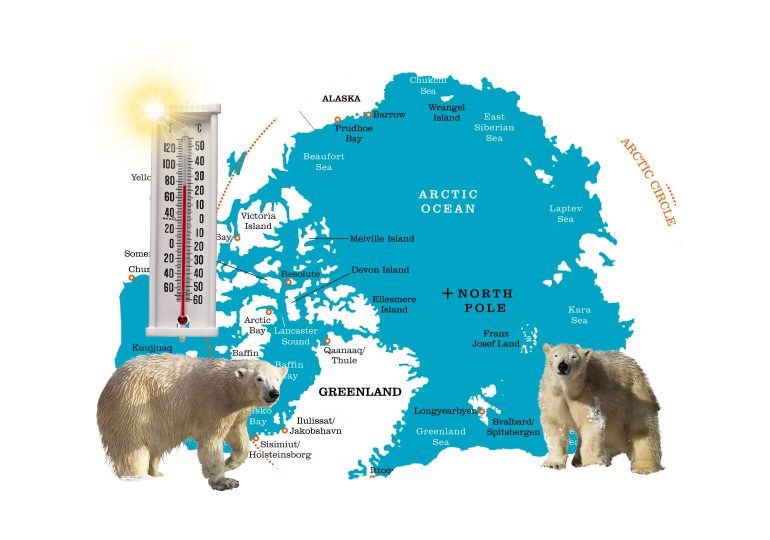Due to global warming, the Arctic region has emerged as a new sphere of rivalry for resources and influence between both Arctic and non-Arctic actors. The melting of the polar ice cap has made this remote area unprecedently accessible. States, such as Russia and China, have demonstrated their aspirations to gain access to previously unattainable energy resources and potential transport routes. Moscow has already expanded its presence in the Arctic to utilize the economic and military potential of the region while China has proclaimed itself as a ‘near-Arctic’ state to create a new trade route – the Polar Silk Road. Russian and Chinese Arctic ambitions have increased attention in the West. For instance, the High North issue was addressed by the NATO Summit in Brussels on June 14. The Alliance agreed on a long-term climate action plan to help mitigate the emerging competition threatening the alliance’s security. However, Beijing and the Kremlin are already gaining more influence over the Arctic and the West needs to act rapidly and develop a concrete and comprehensive strategy to deter the increasing Russian and Chinese threats in the region.
Russia has one of the biggest military presences and territorial claims in the Arctic since it controls roughly 50% of the Arctic Ocean’s coastline. Despite that, after the collapse of the Soviet Union, the Kremlin always considered the region as an area of peace and international cooperation in tackling common challenges. The cooperative spirit consequently led to the creation of the Arctic Council in 1996 which was comprised of the US, Russia, Denmark, Canada, Finland, Iceland, Norway and Sweden. The Council’s main objective was to foster collaboration between littoral states on common interests of tackling environmental challenges and developing scientific research and it largely omitted the issue of military security. Nevertheless, as the relationship between Russia and the West gradually reached the lowest level after the Crimean annexation, the Kremlin started aligning its Arctic agenda with its great power ambitions by increasing its military and economic presence in the region. In 2014, Putin’s administration developed an updated national strategy for the Arctic region for the period up to 2035. The document prioritized the protection of Russian interests in the region and somewhat neglected the previous cooperative approach of the Council. Furthermore, the Kremlin adopted rhetoric claiming that growing Western encroachment in the region posed challenges to its interests. Thus, the ‘zone of peace’ gradually became an intrinsic part of Moscow’s strife for great power status and a new theatre of competition.
Russia is heavily dependent on the Arctic for energy resources since around 80% of its natural gas resources and 17% of its oil are extracted in this region. According to the Kremlin’s projections, the economic benefits of unexplored natural resources have the potential to reach USD 30 trillion which would be crucial for the revitalization of the country’s declining economy. Thereby, Russia continues to boost its military presence in the region to protect its interests. It is set to bolster its defence, and economic security and acquire a new ground for its power projection in the event of a sudden conflict with NATO.
While the northern ice cap continues melting, Russia has already expanded its presence in the north. Its military activities are headquartered on the Kola Peninsula which hosts Russia’s most advanced air and maritime bases and even nuclear weapons. The militarized peninsula neighbours of both the Arctic and the northern Atlantic regions and its advantageous location make it vital to Russia’s security interests. Apart from military activities, Moscow focuses on infrastructure projects and natural resources as well as the development of the Northern Sea Route. Russia’s military deployments stretch between the eastern and western parts of Russia’s Arctic coastline which fulfils the Kremlin’s ambition to significantly enhance maritime traffic and Russia’s military presence in the region.
While a great deal of attention is being paid to Russia’s activities in the Arctic, China has been propelling its ambitions in the north with long-term development plans. The ever-increasing geopolitical and economic viability of the Arctic, revealed by the impact of climate change, led Beijing to develop its Arctic agenda. Becoming one of the 13 observer states of the Arctic Council in 2013, China has procured an opportunity to expand its objectives in the region. The country sees the Arctic as a region crucial for its security as well as a mechanism to refine its image as a global actor and a full-fledged maritime superpower.
The Arctic is a geopolitical opportunity that constitutes a number of alternative polar routes for shipping and can be beneficial for the further development of Beijing’s Belt and Road Initiative (BRI). The incorporation of polar waters in the BRI will help China easily connect to Europe and the Americas with additional routes. These routes can offer safer alternatives to Beijing as compared to current shipping passages. For instance, the Strait of Malacca, which is part of the Maritime Silk Road, is considered the most dangerous water path in the world due to the high rate of piracy incidents. Additionally, the Polar Silk Road could reduce the distance from China to Europe by 40% and cut down costs. Hence, it would be beneficial for Beijing to allow Chinese trading flows to pass through northern sea routes.
China has already revealed its ambitions to embody its far-reaching ambitions in the region by introducing an official ‘white paper’ of its Arctic Policy in 2018. Regardless of its distant location from the Arctic Circle, Beijing declared itself a ‘near-Arctic’ state and even launched a ‘Polar Silk Road’ economic plan. According to the Chinese government, changes in the Arctic directly affect Beijing’s interests. China finds it difficult to establish a military base in the Arctic although it tries to apply bilateral measures to legitimize its role in the Arctic and gain leverage, especially in terms of economic activity. Thus, introducing the Polar Silk Road as part of the BRI has been a framework for increasing the Chinese presence in the region by developing new shipping routes and infrastructure projects. To achieve its goal, Beijing actively invests in the region and, despite energy cooperation with Russia, it has managed to become one of the largest foreign investors in Greenland, Iceland and Finland.
Russia’s resurgent presence, the deployment of Chinese naval vessels and the building of its first icebreaker in the Arctic are all raising questions in the West on how to keep the Arctic secure and conflict-free. These shifting security dynamics in the Arctic spark debates among Western allies which remain divided on how to approach the evolving situation. The US has been the most committed to deterring Russian muscle-flexing and China’s ‘peaceful rise’ in the region. The melting of the polar ice hitherto seems to be an irreversible event, at least in the short term. Therefore, NATO should develop a coherent strategy aimed at not only reversing climate change but also deterring the surging presence of its hostile counterparts in the region. The future memberships of Sweden and Finland should be utilized by the Alliance in deterring the Russian and Chinese threats in the Arctic region.


















